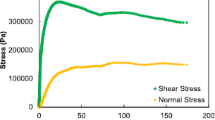Abstract
Poor interface bonding conditions reduce the bearing capacity of asphalt pavements and lead to several distresses. In particular, the association between localized interface debonding and near-surface longitudinal cracking was detected by field observations in the United States. Prediction of potential location and extent of localized interface debonding is important to preclude near-surface cracking. However, there is limited information regarding the onset of localized interface debonding induced by bending. Since interface debonding location and extent may depend on pavement structure, material properties, and loading conditions, a practical approach is needed. Several researchers adopted an equivalent elastic approach to overcome the complexity of modeling the viscoelastic responses of asphalt when evaluating the impact of multiple factors. Therefore, this study focused on determining whether the equivalent elastic approach can be used to identify the potential location of bending-induced localized interface debonding without a significant loss of accuracy. The viscoelastic and equivalent elastic analyses were conducted using 3-D finite element models developed to simulate an asphalt pavement subjected to a moving load. The 3-D equivalent elastic analysis appeared to be sufficient to accurately determine the potential location and extent of localized debonding induced by bending, which are mainly controlled by presence of shear stress in combination with low confinement on the horizontal interface plane. Furthermore, localized debonding was found to likely occur along a strip in the longitudinal direction which resembles a plane-strain problem. This study substantiated that future research efforts can focus on the transverse cross-section when assessing the impact of localized debonding.










Similar content being viewed by others
References
Petit C, Chabot A, Destrée A, Raab C (2018) Interface debonding behavior. In: Buttlar WG, Chabot A, Dave EV, Petit C, Tebaldi G (eds) Mechanisms of cracking and debonding in asphalt and composite pavements: state-of-the-art of the RILEM TC 241-MCD. Springer, Cham, pp 103–153. https://doi.org/10.1007/978-3-319-76849-6_3
Willis J, Timm D (2007) Forensic investigation of debonding in rich bottom pavement. Transp Res Rec 2040:107–114. https://doi.org/10.3141/2040-12
Roque R, Chun S, Zou J, Lopp G, Villiers C (2011) Continuation of superpave projects monitoring. Final Report of Florida Department of Transportation FDOT-BDK-75-977-06, University of Florida, Gainesville, FL
Roque R, Hernando D, Park B, Zou J, Waisome JAM (2017) Evaluation of asphalt pavement interface conditions for enhanced bond performance. Final Report of Florida Department of Transportation FDOT-BDV31-977-37, University of Florida, Gainesville, FL
Hernando D, Waisome JAM, Zou J, Roque R (2018) Identification of potential location and extent of localized interface debonding in the wheelpath of asphalt pavements. Transp Res Rec 2672(40):371–381. https://doi.org/10.1177/0361198118758636
Hernando D, Magruder JA, Zou J, Roque R (2016) Localized debonding as a potential mechanism for near-surface cracking. In: Chabot A, Buttlar W, Dave E, Petit C, Tebaldi G (eds) 8th RILEM international conference on mechanisms of cracking and debonding in pavements. Springer, Dordrecht, pp 569–574. https://doi.org/10.1007/978-94-024-0867-680
Cho S-H, Karshenas A, Tayebali AA, Guddati MN, Kim YR (2017) A mechanistic approach to evaluate the potential of the debonding distress in asphalt pavements. Int J Pavem Eng 18(12):1098–1110. https://doi.org/10.1080/10298436.2016.1149837
Ozer H, Al-Qadi IL, Wang H, Leng Z (2012) Characterisation of interface bonding between hot-mix asphalt overlay and concrete pavements: modelling and in situ response to accelerated loading. Int J Pavem Eng 13(2):181–196. https://doi.org/10.1080/10298436.2011.596935
Huang YH (1993) Pavement analysis and design
Bodin D, Chupin O, Denneman E (2017) Viscoelastic asphalt pavement simulations and simplified elastic pavement models based on an “equivalent asphalt modulus” concept. J Test Eval 45(6):1887–1895. https://doi.org/10.1520/JTE20160652
Albayati AH, Al-Mosawe H, Fadhil AT, Allawi AA (2018) Equivalent modulus of asphalt concrete layers. Civ Eng J 4(10):2264–2274
Chabot A, Tamagny P, Poche D, Duhame D (2006) Visco-elastic modelling for asphalt pavements - software ViscoRout. In: 10th international conference on asphalt pavements, 937-346 ISBN: 978-1-61782-084-7
Chun S, Kim K, Greene J, Choubane B (2015) Evaluation of interlayer bonding condition on structural response characteristics of asphalt pavement using finite element analysis and full-scale field tests. Constr Build Mater 96:307–318. https://doi.org/10.1016/j.conbuildmat.2015.08.031
Bonaquist RF (2008) Refining the simple performance tester for use in routine practice, vol 614. Transportation Research Board
Kim J, Byron T, Sholar GA, Kim S (2008) Comparison of a three-dimensional viscoelastic pavement model with full-scale field tests
Wang H (2011) Analysis of tire-pavement interaction and pavement responses using a decoupled modeling approach. University of Illinois at Urbana-Champaign, Champaign
Acknowledgements
The authors would like to acknowledge and thank the Florida Department of Transportation for providing financial and technical support for this study.
Author information
Authors and Affiliations
Corresponding author
Ethics declarations
Conflict of interest
The authors declare that there is no conflict of interest.
Additional information
Publisher's Note
Springer Nature remains neutral with regard to jurisdictional claims in published maps and institutional affiliations.
Rights and permissions
About this article
Cite this article
Park, B., Zou, J., Hernando, D. et al. Investigating the use of equivalent elastic approach to identify the potential location of bending-induced interface debonding under a moving load. Mater Struct 54, 18 (2021). https://doi.org/10.1617/s11527-020-01612-7
Received:
Accepted:
Published:
DOI: https://doi.org/10.1617/s11527-020-01612-7




